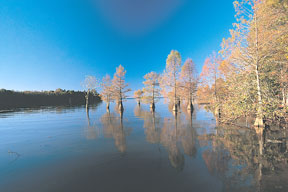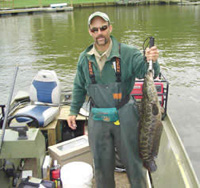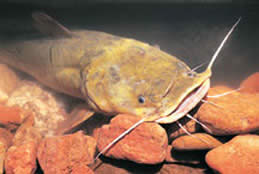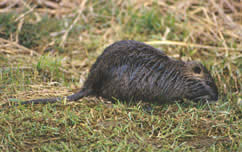Freshwater Animals: Invaders on Feet and Fins
 Whether it came from the blue lagoon or the Blue Mountains, it’s probably coming to South Carolina.
Whether it came from the blue lagoon or the Blue Mountains, it’s probably coming to South Carolina.
The number of non-native aquatic animal species making their homes in South Carolina has risen dramatically in recent years, with an estimated 88 percent of all non-indigenous animals arriving after 1950. Freshwater species account for 82 percent of these exotic intruders, and 49 percent of them are fish.
“A big problem would be fish that can handle our climate, like some Asian carp species that have thrived in the Mississippi,” says Chris Thomason, a freshwater fisheries biologist for the S.C. Department of Natural Resources. “Species like the big-head carp and silver carp have proliferated in the Mississippi River drainage, competing with native species as a big biomass. We don’t want that.”
More than 40 percent of this invading army can trace their roots to North America, while South America and Asia each account for about 20 percent of aquatic invasive species (AIS), according to the U.S. Geological Survey Center for Aquatic Resources Studies. Many of these invasive species were brought to the United States decades ago, but some are just now edging their way across state borders.
“Impacts from invasive aquatic animals often go undetected because they occur under water and out of sight,” warned Steve de Kozlowski, assistant deputy director for the DNR’s Land, Water and Conservation Division and chairman of the S.C. Aquatic Plant Management Council. “But let them clog one power-plant intake or city drinking water withdrawal and they’ll get your attention.”
These exotic animals can eradicate native competitors, confound local food chains and perpetuate disease.
And many first arrived with the best of intentions. In fact, most invading fish species were purposely introduced during the 1960s and 1970s for aquaculture (usually as a second crop for the catfish industry), sportfishing or to help control local vector-borne afflictions.
“People once thought introducing these species would do some good, either by providing food or solving a problem,” says Thomason.
Because environmental impacts are notoriously difficult to project, South Carolina now tries to limit species introduction through an intensive permit process.
 “These invasive species may have some qualities that are beneficial, but any benefits are usually far outweighed by the problems they can cause,” says Chris Page, program coordinator for the DNR’s Aquatic Nuisance Species Program.
“These invasive species may have some qualities that are beneficial, but any benefits are usually far outweighed by the problems they can cause,” says Chris Page, program coordinator for the DNR’s Aquatic Nuisance Species Program.
Some non-native freshwater fish considered harmful include the spotted bass, white perch, green sunfish, Asian swamp eel and snakehead fish. A poster child for regional environmental differences, the white perch thrives in its native rivers along the Carolina coast, but has caused substantial damage in Upstate reservoirs. The snakehead fish has also demonstrated its versatility, multiplying in both the Potomac River and parts of Florida, where it has shown its ability to become established as a top predator.
 The DNR is particularly concerned about the flathead catfish, a predatory, fish-eating catfish. It became popular in the 1960s when it was stocked in Lake Thurmond and the Santee-Cooper lakes along with blue catfish.
The DNR is particularly concerned about the flathead catfish, a predatory, fish-eating catfish. It became popular in the 1960s when it was stocked in Lake Thurmond and the Santee-Cooper lakes along with blue catfish.
“In those days, it was standard procedure to try to stock different species for food and sport without knowing the long-term effects,” says Thomason. “But the flathead catfish is a top predator in any system.”
The flathead catfish and blue catfish are popular, thriving fish in the vast environment of the Santee-Cooper lakes. However, when they find their way to small, low-fertility river systems like the black waters of the Edisto, they can completely wipe out native species like bullheads and shellcrackers.
Georgia has made several unsuccessful attempts to eradicate the flathead catfish, but the animal’s reproductive prowess and ability to tolerate both warm and cool waters make it extremely versatile. The DNR projects that South Carolina may be able to establish a minimal level of control by applying angling pressure, but the flathead catfish is now a permanent part of the Palmetto State’s ecosystem.
“These catfish are an example of invasive species that some people are happy to see and other people see as a real problem,” says Thomason. “With some other species, everyone is in agreement that we don’t want them.”
Red crayfish top the list of concerns for crustacean invaders, but mollusks may pose the greatest freshwater animal threat for the future.
“I think our next threat may be a small clam or snail that gets into our waterways,” says de Kozlowski. “They can reproduce very, very fast, and that would be a problem.”
Viviparid snails like the olive mystery snail (Viviparous subpurpureus) are not usually considered invasive, but the discovery of millions of their shells along the beaches of Lake Marion has forced scientists to reconsider the evidence. The Lake Marion shells also mark the first known report of this Southeast Asian mollusk in an Atlantic drainage area.
 Zebra mussels also have the DNR on its toes.
Zebra mussels also have the DNR on its toes.
“If zebra mussels established themselves as an infestation, we would have problems,” says de Kozlowski. “Fortunately, we don’t think the soft water throughout most of the state creates a conducive environment for them.”
As filter feeders, zebra mussels remove phytoplankton—which often serve as the primary energy source for the entire aquatic food chain—from the water. They tend to colonize on native mollusks, preventing valve function and essentially smothering the competition. Zebra mussels can also attach to unprotected docks, boats, breakwalls, engine outdrives and water-intake pipes.
Another hearty mollusk, the Asian clam, spread through the United States in the 1930s through human activities like bait dumping and aquarium releases. Its larvae can also passively navigate water currents, providing a secondary means of dispersion. The Asian clam serves as a tasty treat for many popular game fish, but this invasive species is also responsible for killing native freshwater mussels and fouling power-plant water intakes.
 While not yet here, the most threatening invasive freshwater mammal identified by the S.C. Invasive Species Task Force is the nutria, a large rodent that was first brought to America from Argentina before World War II to help control aquatic weeds.
While not yet here, the most threatening invasive freshwater mammal identified by the S.C. Invasive Species Task Force is the nutria, a large rodent that was first brought to America from Argentina before World War II to help control aquatic weeds.
The nutria’s tendency to devour marsh grasses and burrow extensive underground tunnels incurred the wrath of rice and sugarcane farmers by the 1950s, but its valuable pelts boosted the animal’s popularity. In fact, extensive fur harvesting led to a protected wildlife distinction for the animal in 1965. When the fur market declined in the 1980s, the nutria population experienced a resurgence, leaving wetland damage in its wake.
“Nutria are on the list of animals of concern,” Thomason says. “They’ve become a big species in Louisiana and are actually in North Carolina right now. So we can certainly expect to see them here at some point.”
Related Items:
- Invasion of the Aquatic Exotics
- Freshwater Animals: Invaders on Feet and Fins
- Aquatic Invasive Species: SC’s Most Wanted
- Freshwater Plants: Tenacious Tendrils
- Tiny Enemy Hiding In Hydrilla
- Marine Animals: Coming in on the Tides
- Marine Plants: Commanding the Coastline
- Get the Complete document in PDF format
Text for this supplement by Marc Rapport, free-lance writer and senior writer for the S.C. Department of Parks, Recreation & Tourism.
© 2007 South Carolina Wildlife magazine, July - August 2007

